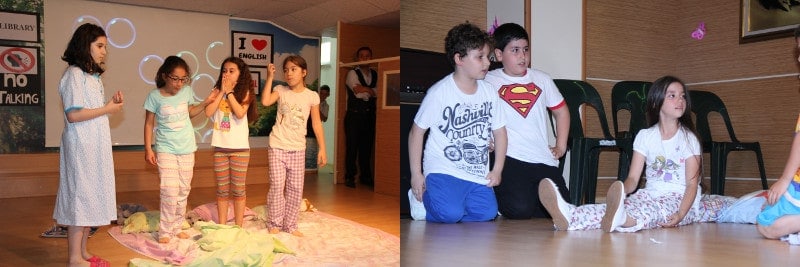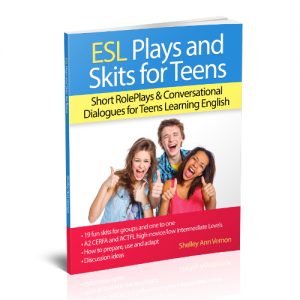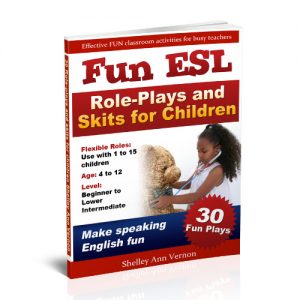An end of term show can seem like a daunting task for an ESL teacher!
Why give a show?
An end of term show is a fantastic way to motivate kids. It’s also important to share your work with parents and the school. Finally, it’s a chance for students to show off and be rewarded for their efforts.
Fears – No English and No ideas?
However, many teachers fear attempting to showcase English class since the level is so low, they can’t think what to do! In traditional English classrooms, most pupils are incapable of speaking basic English, let alone putting on a show in English. However, teachers using my games and methods will not have this problem.
Here are ideas for content for the show. Read on to feel more confident about undertaking the challenge of an end of term English show.

The End of Term Show
When I gave an end of term shows for parents, here is what I do:
1. Firstly, I showcase some vocabulary games. Here pupils show off their knowledge of vocabulary learned through the term or year. These activities include showing vocabulary flashcards, naming pictures and objects, and miming words.
2. Next, we might perform actions to a song, singing along in the chorus.
3. I might then stage a game of Simon Says and have the audience join in.
4. Next I might stage a quiz, with pupils in teams. Questions would cover language learned throughout the year, such as, “What’s your name? Where do you live? What is this?” And, if applicable, I could include general knowledge questions. Of course, I would always ask questions I knew my students could answer. And for any weak students, I would ask the simplest questions of all, such as, “What colour is this?”
5. Small groups are a luxury because one can present short skits or plays. These are the pièce de résistence of my shows! The advantage of my role-plays for children is that the lines are simple and repetitive. All students know all the lines. This way, you don’t have the nightmare of your main character not showing up on the day because he is home with the flu! Anyone can step in and take any role.
6. Other ideas for content are reciting a simple poem over a rhythm. Use boxes as drums. Kids pat on the boxes in a rhythm and recite the poem. Include percussion and music in the show. For example, have kids “play” saucepans. You’ll notice that each pan has a note! The same goes for bottles. Make shakers from everyday items, such as putting sand inside a plastic bottle. Recite simple rhymes over a rhythm.
7. If you have time, the kids might each write a program.
8. Equally, you might make props together.

Show Preparation Tips
1. Start early. Prepare little and often throughout the term. This approach allows for repetition and revision. There is plenty on preparing a skit in my book of plays.
2. Always prepare without written prompts. Everything should be committed to memory from day one. You achieve this through repetition and building content gradually. Some teachers give out scripts. Going through them is laborious and lacks spontaneity.
Pupils can work on the script at their desks with, for example, a grammar treasure hunt or a jigsaw puzzle. But expecting children to learn a play through reading the script is a recipe for boring lessons and hesitant performance.
3. Break it up. Teach other topics alongside the show content. Spend 15 minutes on the performance at each lesson, then move on to something else. Variety keeps the show preparation fresh and exciting.
4. Keep props simple and use them at the end, only once the script is thoroughly learned. At first, they are a distraction! However, once children know their lines, the prop becomes an asset.
5. Remember to invite the parents with enough warning. Ask the head of school if you may perform your show, or part of it, at a school assembly.
What if the kids freeze up?
Your students might freeze up on the night and be tongue-tied! This happened to me, but only once! Using the above structure for your show, starting with some group vocabulary games, you won’t have any trouble with shyness. Children begin by performing easy tasks as a group. Then, proceed with a song. Next, ask easy questions they know. By the time you come to the skit, pupils feel at home on stage in front of the crowd. If you have to prompt, don’t give the whole line, just the first word.
Subtitles!
I was once astonished when a parent complained that he could not understand the content of my show. The kids had progressed so much they couldn’t follow it! Therefore, you might consider giving shy students the role of showing subtitles. This activity will help their English progress without forcing them to speak in public if they feel uncomfortable. Otherwise, give a resumé of the action to help those parents who speak no English at all.
Oh, and don’t forget to have someone film the performance. Playing it back to the kids is a valuable revision opportunity.
Resources
Get my plays and games books to help you give a great end of term English show!
Here is my author page for paperbacks.
-
Sale Product on sale
 Plays and Skits for Teens
Plays and Skits for Teens€19.97Original price was: €19.97.€15.33Current price is: €15.33.Rated 5.00 out of 5 based on 1 customer rating -
Sale Product on sale
 Fun ESL Role-plays and Skits for Children
Fun ESL Role-plays and Skits for Children€19.97Original price was: €19.97.€15.33Current price is: €15.33. -
Sale Product on sale
 ESL Games book for primary & middle school children
ESL Games book for primary & middle school children€19.97Original price was: €19.97.€15.33Current price is: €15.33.Rated 5.00 out of 5 based on 1 customer rating



